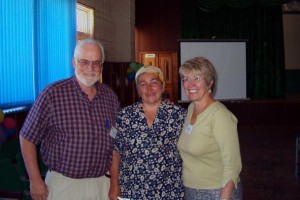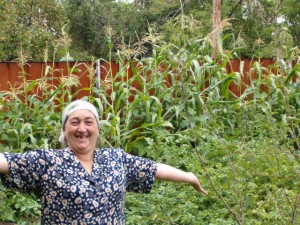In the 1960s, Peace Corps volunteers began their 27 months of service with 12 weeks of “pre-service training” somewhere in the US. But between then and when we showed up in 2004, Peace Corps had moved the training programs out of the US and into each of the one hundred or more countries in which they served.
In this new model, training staff was comprised mostly of locals, able to introduce the volunteers to the culture and language of their own country. Our group, dubbed KAZ15 — for we were the fifteenth group of volunteers in Kazakhstan — followed this now-ten-week Training model.
Forty-two future volunteers gathered in Washington DC one Thursday morning, flew to Almaty , Kazakhstan via Frankfurt, Germany the next Sunday afternoon, and settled in at a mountainside sanitorium for a three-day orientation and jet-lag recovery.
###
Training had two parts: cultural acclimatization and language learning. And each occured in both classroom sessions and host family life.
On our third day in Kazakhstan, we met our host family with whom we’d live for the duration of the ten-week training period. I was looking forward to living with a local family. It would be, I believed, the start of the single most important aspect of my Peace Corps experience: meeting and getting to know the local people.
It was a choreographed event. The Peace Corps staff divided the forty-two of us into five groups, depending upon where we’d be living during the coming ten weeks. Woody and I would live in Esik, a large village fifty kilometers east of Almaty and the hub site of all collective trainee activity. So we and nine other trainees filed upstairs to the auditorium as directed.
We stood quietly against a side wall and saw headscarves for the first time as older, married village women, more traditional than the younger, urban Kazakhstani staff, arrived to claim their charge.
A short, round woman about my age broke through the crowd, looked straight at us, then down to the photos in her hand. Her face creased into a smile that revealed a gold-capped tooth, a common feature of “good dental care” throughout Kazakhstan. Her widening smile also revealed a missing front tooth.
She had an air of earth-mother self-confidence and we hugged instinctively.
I proudly offered my, “D’rast v’witchya. Kak dila?” (Hello, how are you?) I’d been practicing all morning, adding, “Meenya zavoot, Janet.” Her name was Hadija but it was a full week before I could remember it, let alone the names of the rest of the family. My brain, I’d noticed, seemed to allow only so much “new” into it each day.

Overall, life with Hadija and her family was good. I found it a happy home, filled with the noises that accompany a house with four teenagers. Hadija and her husband Mamluk had three daughters and a son.
Mamluk was a truck driver, picking up milk a few times a week across the mountains in Uzbekistan to bring back for processing at the local milk factory. I found him to be a man with a good heart and an easy smile, chuckling when I teasingly called him “Papa Luke.”
But we spent most of our time on the weekends and in the evenings when we’d come home from our lessons with the women.
Fatima, the oldest at eighteen, was the quietest. Much of the cooking and cleaning fell to her, and she either enjoyed it or had come to terms with it. It was hard to tell.
Takhmina was seventeen and had an artistic bent. She didn’t enjoy cooking or cleaning, though she regularly helped her sisters and mother. It was adorning herself and her sisters, primping, costuming, applying makeup, and giving exquisite manicures that brought her joy.
Soniya was sixteen and the student of the family. She studied English in school, and I soon began to rely on her, though she was shy when speaking. Still, her English improved dramatically while we were there, while I can’t say the same for my Russian.
A son, Murcel, would turn fourteen in July. He was more difficult to know, often playing outside — na ulitza, in the street — with his cousins. What I do remember of Murcel was that he was late for dinner regularly and each time he came in, one of his sisters would jump from her seat to fetch his plate. No one told her to, and no one complained or criticized Murcel, either.
The Russian word for brother is brat and Woody enjoyed teaching Soniya the English meaning of the word. She’d walk around the house saying in English, “My brother is a brat; my brother is a brat,” and loved having this secret with us.
We lived with them in a sprawling ranch, behind a badly rusted fence that created a front courtyard with a rose garden taking up the left half. What stood out in that front yard though was the 18-wheeler that took up the other half: Mamluk’s milk truck.
Once past the truck, the front door opened into a large, clean kitchen with a shining linoleum floor and a living room with an eating area beyond. Two wings spanned off from the kitchen in opposite directions.
The wing to the left held six rooms where everyone slept, the two at the farthest end turned over to us.
To the right were the vanna (the closest room to a bathroom, with a tub and a sink, but no toilet) and the banya (a marvelous invention, part sauna, part meditation center) where we bathed each Saturday night.
Off the kitchen, another door led to the back yard. Except for the small outhouse in the far right corner not thirty feet from the back door and a dozen or so fruit trees, the thirty by thirty-five foot plot was one solid vegetable garden.
This was Hadija’s pride and she spent the cooler early morning and late evening hours tending to it lovingly.

City girl that I was, I had no idea what she was growing, other than corn, but the rows were carefully laid out, weeds were nearly non-existent, and the young plants along the garden path were so lush, we had to push them aside as we made our way to the outhouse.
They lived in a neighborhood of Esik known as Stanbul, a Turkish hamlet, which meant nothing more to us at first than a reminder of the diversity of the population. All I knew was that we had more than enough space, had settled in comfortably, and enjoyed being there.
More important, the family seemed to genuinely enjoy us, something not all of our fellow trainees could say.
How about you? What memories do you have of living in someone else’s home?
Leave a Reply